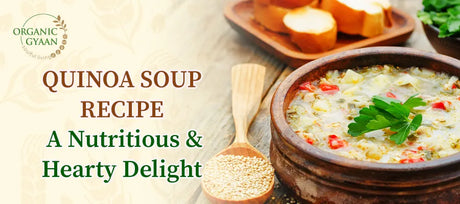
Quinoa Soup Recipe: A Nutritious & Hearty Delight
By Organic Gyaan
Wholesome, gluten-free quinoa (or millet) soup made without onion or garlic—light, nourishing, and perfect for digestion and daily wellness.
Read more




Kodo millet flour, made from unpolished Kodo millet (also known as Kodra, Varagu Millet, Koden, Arikelu, Harka, or Koovaragu), is a powerhouse of nutrition rooted in ancient Indian food traditions. Known for its blood-purifying properties, high fiber content, and low glycemic index, this flour is ideal for diabetics, heart patients, and anyone looking to maintain balanced energy and better gut health.
Our organic kodo millet flour is not just ground grain—it’s activated, meaning the UNPOLISHED millet is soaked, gently dehydrated, and stone-ground to preserve nutrients and enhance digestibility.
Most regular flours are made from dry grains, which can be hard on digestion. Our kodo millet flour undergoes a 3-step activation process:
This process improves the bioavailability of vital minerals like iron, magnesium, zinc, and calcium, making it a gut-friendly, nutrient-dense choice. It's especially beneficial for those following fasting protocols or managing chronic conditions.
These kodo millet flour benefits make it a must-have in every kitchen aiming for holistic wellness.
Perfect for both fasting and daily meals, kodo millet flour is light, sattvic, and versatile.
Best For:
This flour works beautifully in both traditional Indian recipes and modern, gluten-free baking.
To make nourishing, soft rotis with kodo millet flour:
This method ensures digestibility, softness, and a light texture—perfect for fasting, healing, or daily meals.
Our organic Kodo millet flour is crafted with care and consciousness—offering more than just convenience; it delivers true nourishment.
Incorporating Kodo millet flour into your daily cooking is a simple yet powerful step toward better health. With its exceptional fiber content, natural blood-purifying properties, and low glycemic index, this ancient grain supports holistic healing from within.
Whether you're managing blood sugar, improving digestion, or embracing a clean, gluten-free lifestyle, Kodo millet flour bridges ancient wisdom with modern wellness.
Nourish your body, restore your balance, and cook with intention—make Kodo Millet Flour your everyday healing grain.
1. What is kodo millet flour?
Kodo millet flour is a type of flour made from the seeds of the kodo millet plant. Kodo millet is a small, gluten-free grain that is commonly grown in India and other parts of Asia.
2. Is kodo millet flour gluten-free?
Yes, kodo millet flour is gluten-free, which makes it a great option for people who have celiac disease or gluten intolerance.
3. What are the nutritional benefits of kodo millet flour?
Kodo millet flour is rich in dietary fiber, protein, and various vitamins and minerals, including iron and magnesium. It is also a good source of antioxidants and may help regulate blood sugar levels.
4. How is kodo millet flour used in cooking?
Kodo millet flour can be used in a variety of dishes, including bread, pancakes, dosas, and rotis. It has a slightly nutty flavor that works well in both sweet and savory dishes.
5. How should I store kodo millet flour?
Kodo millet flour should be stored in an airtight container in a cool, dry place. It can also be stored in the refrigerator or freezer to extend its shelf life.
6. Can kodo millet flour be substituted for wheat flour in recipes?
Yes, kodo millet flour can often be substituted for wheat flour in recipes. However, because it is gluten-free, it may require the addition of a binding agent, such as xanthan gum or guar gum, to help the dough or batter hold together. It may also have a different texture or flavor than wheat flour, so experimentation may be necessary.
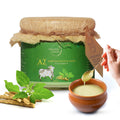 Best Quality Guaranteed
Best Quality Guaranteed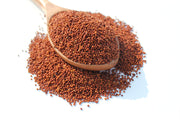 Free from Chemical & Pesticides | NO GMO
Free from Chemical & Pesticides | NO GMO
 Best Quality Guaranteed
Best Quality Guaranteed Free from Chemical & Pesticides | NO GMO
Free from Chemical & Pesticides | NO GMO
 Best Quality Guaranteed
Best Quality Guaranteed Free from Chemical & Pesticides | NO GMO
Free from Chemical & Pesticides | NO GMO
 Best Quality Guaranteed
Best Quality Guaranteed Free from Chemical & Pesticides | NO GMO
Free from Chemical & Pesticides | NO GMO
 Best Quality Guaranteed
Best Quality Guaranteed Free from Chemical & Pesticides | NO GMO
Free from Chemical & Pesticides | NO GMO
 Best Quality Guaranteed
Best Quality Guaranteed Free from Chemical & Pesticides | NO GMO
Free from Chemical & Pesticides | NO GMO
 Best Quality Guaranteed
Best Quality Guaranteed Free from Chemical & Pesticides | NO GMO
Free from Chemical & Pesticides | NO GMO
 Best Quality Guaranteed
Best Quality Guaranteed Free from Chemical & Pesticides | NO GMO
Free from Chemical & Pesticides | NO GMO
 Best Quality Guaranteed
Best Quality Guaranteed Free from Chemical & Pesticides | NO GMO
Free from Chemical & Pesticides | NO GMO
 Best Quality Guaranteed
Best Quality Guaranteed Free from Chemical & Pesticides | NO GMO
Free from Chemical & Pesticides | NO GMO
 Best Quality Guaranteed
Best Quality Guaranteed Free from Chemical & Pesticides | NO GMO
Free from Chemical & Pesticides | NO GMO
 Best Quality Guaranteed
Best Quality Guaranteed Free from Chemical & Pesticides | NO GMO
Free from Chemical & Pesticides | NO GMO
 Best Quality Guaranteed
Best Quality Guaranteed Free from Chemical & Pesticides | NO GMO
Free from Chemical & Pesticides | NO GMO
 Best Quality Guaranteed
Best Quality Guaranteed Free from Chemical & Pesticides | NO GMO
Free from Chemical & Pesticides | NO GMO
 Best Quality Guaranteed
Best Quality Guaranteed Free from Chemical & Pesticides | NO GMO
Free from Chemical & Pesticides | NO GMO
 Best Quality Guaranteed
Best Quality Guaranteed Free from Chemical & Pesticides | NO GMO
Free from Chemical & Pesticides | NO GMO
 Best Quality Guaranteed
Best Quality Guaranteed Free from Chemical & Pesticides | NO GMO
Free from Chemical & Pesticides | NO GMO
 Best Quality Guaranteed
Best Quality Guaranteed Free from Chemical & Pesticides | NO GMO
Free from Chemical & Pesticides | NO GMO
 Best Quality Guaranteed
Best Quality Guaranteed Free from Chemical & Pesticides | NO GMO
Free from Chemical & Pesticides | NO GMO
 Best Quality Guaranteed
Best Quality Guaranteed Free from Chemical & Pesticides | NO GMO
Free from Chemical & Pesticides | NO GMO

By Organic Gyaan
Wholesome, gluten-free quinoa (or millet) soup made without onion or garlic—light, nourishing, and perfect for digestion and daily wellness.
Read more
By Organic Gyaan
Millet kheer is a wholesome twist to traditional dessert—rich in fiber, calcium, and flavor. A perfect blend of health, tradition, and indulgence!
Read more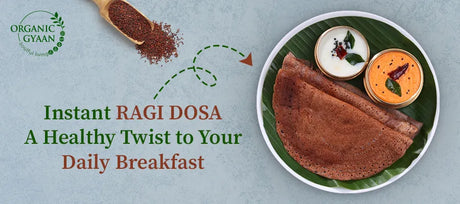
By Organic Gyaan
Instant Ragi Dosa is your perfect 15-min satvik breakfast—gluten-free, diabetic-friendly, and rich in calcium, fiber, and plant protein. Try it today!
Read more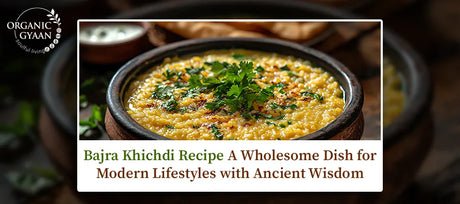
By Organic Gyaan
Discover the goodness of bajra khichdi—a simple, nourishing meal packed with fiber, protein, and ancient wisdom for modern, mindful living.
Read more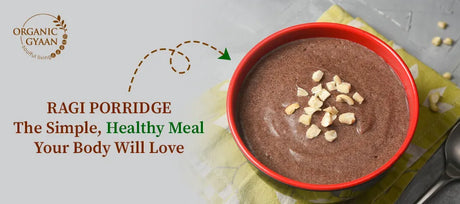
By Organic Gyaan
Ragi porridge is a simple, nourishing meal rich in calcium, fiber, and iron—perfect for kids, diabetics, and anyone seeking wholesome wellness.
Read more
By Organic Gyaan
Looking for a wholesome, plant-based meal? Try Millet Rajma Salad—a high-protein, low-GI, fiber-rich recipe perfect for diabetes, weight loss, and energy.
Read more
By Organic Gyaan
Millet pongal is the ultimate comfort food—wholesome, gut-friendly, and perfect for weight loss, diabetes, and daily nourishment. A smart, tasty swap!
Read more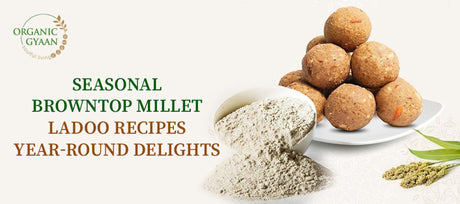
By Organic Gyaan
Brown Top Millet Ladoo is a nutritious and delicious snack that combines the goodness of brown top millet with the richness of traditional Indian sweets.
Read moreWe currently ship to the United States, Canada, Australia and the UK. To enquire about shipping to a different destination, please contact us.
Standard shipping normally takes 3-5 days. Next day shipping is available on all domestic orders (for an additional charge). International shipping times depend on the products and destination (estimated at checkout).
Items must be returned within 30 days after receiving your order. Items must be returned in the same condition in which they were received, be unworn/unused, have any tags still attached, and include all the original packaging.
Refunds are processed within 7 days from when we receive the item(s).






Kodo millet flour, made from unpolished Kodo millet (also known as Kodra, Varagu Millet, Koden, Arikelu, Harka, or Koovaragu), is a powerhouse of nutrition rooted in ancient Indian food traditions. Known for its blood-purifying properties, high fiber content, and low glycemic index, this flour is ideal for diabetics, heart patients, and anyone looking to maintain balanced energy and better gut health.
Our organic kodo millet flour is not just ground grain—it’s activated, meaning the UNPOLISHED millet is soaked, gently dehydrated, and stone-ground to preserve nutrients and enhance digestibility.
Most regular flours are made from dry grains, which can be hard on digestion. Our kodo millet flour undergoes a 3-step activation process:
This process improves the bioavailability of vital minerals like iron, magnesium, zinc, and calcium, making it a gut-friendly, nutrient-dense choice. It's especially beneficial for those following fasting protocols or managing chronic conditions.
These kodo millet flour benefits make it a must-have in every kitchen aiming for holistic wellness.
Perfect for both fasting and daily meals, kodo millet flour is light, sattvic, and versatile.
Best For:
This flour works beautifully in both traditional Indian recipes and modern, gluten-free baking.
To make nourishing, soft rotis with kodo millet flour:
This method ensures digestibility, softness, and a light texture—perfect for fasting, healing, or daily meals.
Our organic Kodo millet flour is crafted with care and consciousness—offering more than just convenience; it delivers true nourishment.
Incorporating Kodo millet flour into your daily cooking is a simple yet powerful step toward better health. With its exceptional fiber content, natural blood-purifying properties, and low glycemic index, this ancient grain supports holistic healing from within.
Whether you're managing blood sugar, improving digestion, or embracing a clean, gluten-free lifestyle, Kodo millet flour bridges ancient wisdom with modern wellness.
Nourish your body, restore your balance, and cook with intention—make Kodo Millet Flour your everyday healing grain.
1. What is kodo millet flour?
Kodo millet flour is a type of flour made from the seeds of the kodo millet plant. Kodo millet is a small, gluten-free grain that is commonly grown in India and other parts of Asia.
2. Is kodo millet flour gluten-free?
Yes, kodo millet flour is gluten-free, which makes it a great option for people who have celiac disease or gluten intolerance.
3. What are the nutritional benefits of kodo millet flour?
Kodo millet flour is rich in dietary fiber, protein, and various vitamins and minerals, including iron and magnesium. It is also a good source of antioxidants and may help regulate blood sugar levels.
4. How is kodo millet flour used in cooking?
Kodo millet flour can be used in a variety of dishes, including bread, pancakes, dosas, and rotis. It has a slightly nutty flavor that works well in both sweet and savory dishes.
5. How should I store kodo millet flour?
Kodo millet flour should be stored in an airtight container in a cool, dry place. It can also be stored in the refrigerator or freezer to extend its shelf life.
6. Can kodo millet flour be substituted for wheat flour in recipes?
Yes, kodo millet flour can often be substituted for wheat flour in recipes. However, because it is gluten-free, it may require the addition of a binding agent, such as xanthan gum or guar gum, to help the dough or batter hold together. It may also have a different texture or flavor than wheat flour, so experimentation may be necessary.
Weight
HIGH NUTRITIONAL VALUE
Organic foods preserve far more vitamins & minerals
NO CHEMICALS & PESTICIDES
We don’t use artificial fertilisers or additives in our food
CERTIFIED ORGANIC SOURCES
Our products quality is verified by top certification bodies
PRESERVES THE ENVIRONMENT
Sustainable farming ensures soil conversation & reduced air pollution